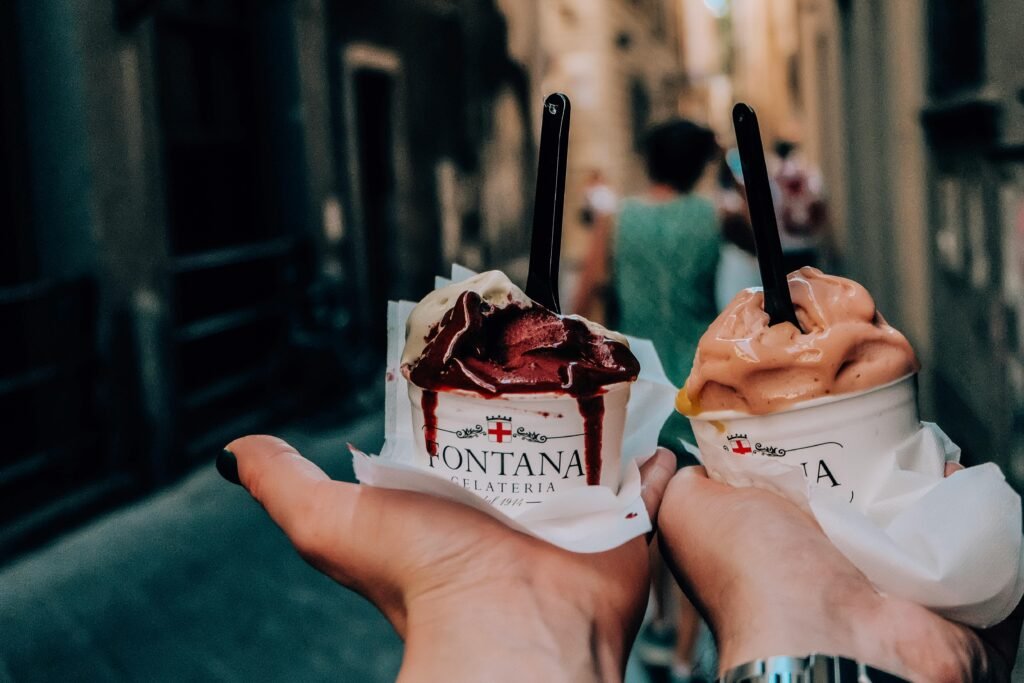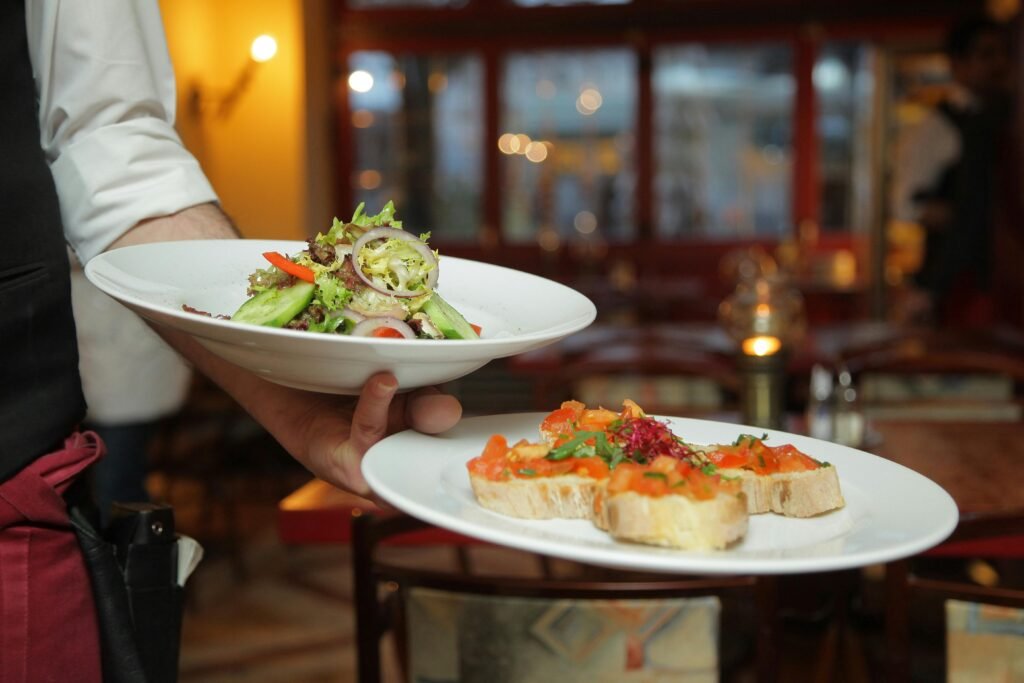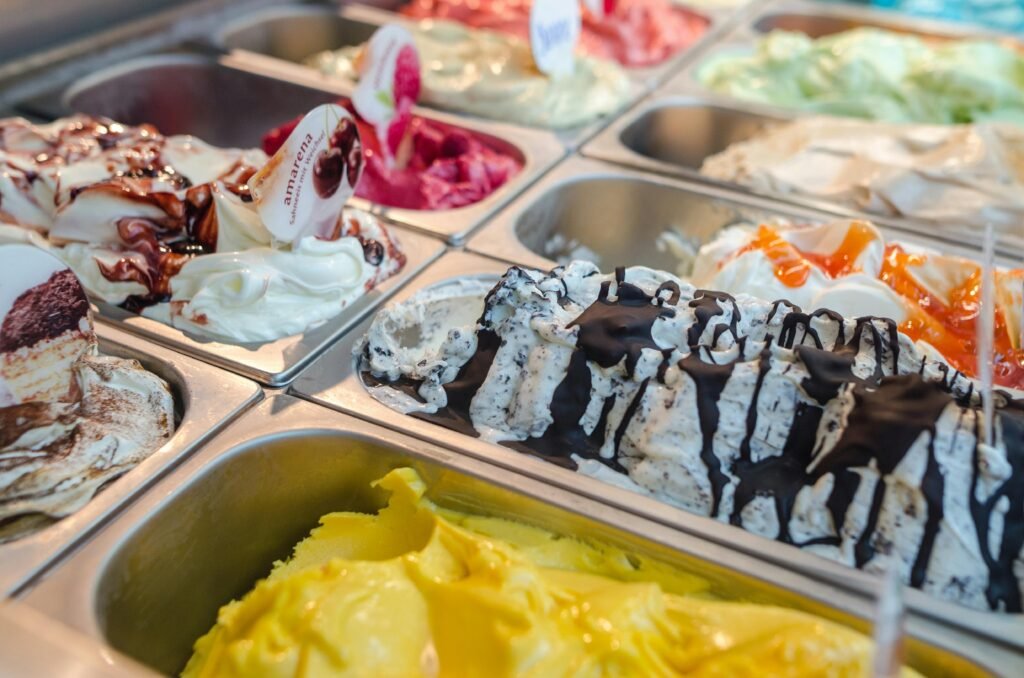The secret behind Florence’s gelato legacy isn’t just one thing – it’s a perfect storm of Renaissance innovation, generational craftsmanship, and an almost obsessive dedication to quality that’s been brewing for over 500 years. And honestly?
Once you understand what makes Florentine gelato so special, you’ll never look at that freezer-burned pint in your grocery store the same way again.
The Renaissance Roots: Where It All Began
You know what’s crazy? I used to think gelato was just Italy’s version of ice cream until I dug into its history during my food writing research. Turns out, Florence didn’t just contribute to the gelato world – they basically invented the whole dang thing!
Back in the 16th century, while most of Europe was still figuring out basic refrigeration, Florentine nobles were already perfecting frozen desserts. The Medici family – yeah, those same art-loving powerhouses who funded Michelangelo – were hosting elaborate banquets featuring what we’d now recognize as primitive gelato. Bernardo Buontalenti, a Renaissance polymath (because apparently being good at just one thing wasn’t enough back then), is often credited with creating the first true gelato around 1565.
But here’s where it gets really interesting. These weren’t just rich people playing around with fancy desserts. The Renaissance culture in Florence created this environment where culinary innovation was treated like an art form. Chefs were experimenting with flavor combinations that seem wild even by today’s standards – rose water with honey, exotic spices from newly discovered trade routes, even savory elements that would make modern foodies lose their minds.
I remember talking to Giuseppe, an 80-year-old gelatiere whose family has been making gelato since the 1800s. He told me something that stuck with me: “In Florence, we don’t just make gelato – we continue a conversation that started five centuries ago.” Every scoop carries the weight of that Renaissance innovation, and you can literally taste the history.
The guild system that dominated Renaissance Florence also played a huge role. Gelato makers formed their own associations, closely guarding recipes and techniques. This created a culture of secrecy and excellence that persists today – many Florentine gelaterias still use family recipes that have been passed down through generations, never written down, just whispered from nonna to grandchild.
Artisan Techniques That Make the Difference
Okay, so here’s where I’m gonna get a little nerdy about gelato production, but stick with me because this is where the magic really happens. I spent a morning at Vivoli, one of Florence’s oldest gelaterias, watching their master craftsmen work, and let me tell you – it’s like watching artists create edible sculptures.
First off, authentic Florentine gelato is churned at a much slower speed than regular ice cream. We’re talking about 20-30 RPMs compared to the 100+ RPMs used in commercial ice cream production. This slower churning means less air gets incorporated – what they call “overrun” in the industry. While commercial ice cream can be up to 50% air, traditional Florentine gelato contains only about 20-25% air. The result? Every bite is denser, more intense, and packed with flavor.
Temperature control is absolutely crucial too. I learned this the hard way when I tried making gelato at home and ended up with what basically amounted to flavored ice chunks. Gelato is served at around 10-15°F warmer than ice cream – typically between 0°F to 10°F. This warmer serving temperature allows the flavors to hit your palate more intensely and creates that signature smooth, almost creamy texture that melts perfectly on your tongue.
The base ingredients are where Florentine gelato makers really show their expertise. Instead of heavy cream like American ice cream, they use more milk and sometimes no cream at all, depending on the flavor. For fruit gelatos, they often use water as the base, which sounds wrong until you taste it and realize it allows the fruit flavors to absolutely sing without any dairy interference.
I watched Marco, a third-generation gelatiere, prepare his pistachio gelato. He didn’t just throw nuts into a machine – he hand-selected pistachios from Sicily, roasted them himself to the exact color and aroma he wanted, then ground them into a paste using techniques his grandfather taught him. The entire process took three days from start to finish. That’s the kind of attention to detail you’re tasting in every spoonful.
Fresh ingredients are sourced daily – and I mean daily. Most authentic Florentine gelaterias make small batches twice a day to ensure peak freshness. They’re not scooping month-old gelato from industrial freezers; they’re serving you something that was probably made that morning with ingredients purchased from local markets just hours earlier.
Local Ingredients: The Soul of Florentine Flavors
This is where I really started to understand why Florentine gelato tastes so different from anywhere else. It’s not just about technique – it’s about what goes into the gelato in the first place. The Tuscan region provides ingredients that you literally can’t get anywhere else in the world, and local gelatieri have spent generations figuring out how to showcase them perfectly.
Take their famous fig gelato, for instance. I tried making something similar back home using figs from my local grocery store, and it was… disappointing. But in Florence, they use fresh figs from the Tuscan countryside – varieties like Dottato and San Pietro that have been grown in that specific soil for centuries. The flavor profile is completely different: more complex, with subtle mineral notes from the volcanic soil and a sweetness that’s balanced by just the right amount of tartness.
The milk comes from local dairy farms where cows graze on wild herbs that grow naturally in Tuscan pastures. I’m not making this up – you can actually taste the difference. There’s a floral quality to the milk that adds depth to every flavor, even the fruit-based ones that don’t technically contain dairy.
Seasonal sourcing is taken so seriously that menus change constantly. During my stay, I watched gelaterias literally remove flavors from their displays when certain ingredients went out of season. No frozen strawberries or artificial flavoring – if fresh local strawberries aren’t available, strawberry gelato disappears from the menu until next season.
The chestnuts used in autumn gelato come from the Casentino forests, where they’ve been harvested using the same methods for over 800 years. The honey in their miele (honey) flavor is sourced from beehives in the Chianti region, where bees feed on acacia and wildflower varieties unique to that microclimate. Even their chocolate comes from specific suppliers who work directly with cacao farmers to create blends that complement the Tuscan palate.
I learned about “terroir” – a concept usually associated with wine – from Elena, who runs a small gelateria in Oltrarno. She explained how the same recipe can taste completely different depending on where the ingredients are sourced. It’s why authentic Florentine gelato can’t be truly replicated elsewhere, no matter how perfectly you copy the techniques.
The Master Gelatieri: Guardians of Tradition
Meeting the master gelatieri of Florence was honestly one of the most inspiring parts of my entire food writing journey. These aren’t just people who learned to make frozen desserts – they’re custodians of a cultural tradition that goes back centuries, and they take that responsibility incredibly seriously.
Most master gelatieri in Florence started their training as teenagers, often working in family businesses that have been operating for multiple generations. The learning process isn’t quick or easy – it typically takes 5-7 years to become proficient, and another decade to truly master the craft. We’re talking about people who can tell the exact sugar content of a batch just by looking at how it churns, who can adjust recipes on the fly based on subtle changes in humidity or temperature.
I spent an afternoon with Signora Carla, whose family has owned the same gelateria since 1932. She told me about the “secret notebook” – a collection of family recipes and techniques that’s never been fully written down. Instead, knowledge is passed through what she calls “hand memory” – the physical experience of feeling when texture is exactly right, when flavors are perfectly balanced, when the churning should stop.
The level of quality control these artisans maintain is almost obsessive. Every batch is tasted multiple times throughout the production process. If something isn’t perfect – maybe the vanilla extract is slightly different from the usual supplier, or the milk has a slightly different fat content – the entire batch gets scrapped. No compromises.
What really struck me was their relationship with customers. These aren’t anonymous fast-food transactions. Master gelatieri remember your preferences, make recommendations based on what you liked last time, and genuinely care about your experience. Franco, who’s been making gelato for 40 years, told me he considers himself successful only when customers leave his shop smiling.
The apprenticeship system is still alive and well. Young gelatieri work alongside masters for years, learning not just recipes but philosophy. They’re taught to respect ingredients, to understand seasons, to view gelato-making as a form of cultural expression rather than just a business. This creates a continuity of tradition that you can taste in every spoonful.
Many master gelatieri also act as innovators within tradition. They’ll experiment with new flavor combinations or techniques, but always within the framework of traditional Florentine methods. It’s evolution, not revolution – maintaining the soul of the craft while keeping it relevant for modern palates.
Seasonal Secrets and Signature Flavors
Here’s something I didn’t expect when I first arrived in Florence – gelato flavors change dramatically throughout the year, and I mean dramatically. Back home, I was used to walking into any ice cream shop and finding the same 31 flavors year-round. But authentic Florentine gelaterias operate more like restaurants with seasonal menus, and honestly, it makes the whole experience so much more exciting.
Spring brings flavors I’d never even imagined. Fresh pea gelato sounds weird until you taste it – it’s subtly sweet with an earthy undertone that’s absolutely addictive. Violet flower gelato appears in March and April, made from actual violet petals gathered from Tuscan hillsides. The flavor is delicate and floral, unlike anything I’d experienced before. Rose petal gelato becomes available when the roses bloom, and let me tell you, it’s nothing like the artificial rose flavoring you might expect – it’s subtle, sophisticated, and incredibly refreshing.
Summer is when fruit gelatos really shine. The peach gelato in July and August is made from white peaches grown in local orchards – the flavor is so intense and pure that it’s like eating sunshine. Watermelon gelato provides perfect relief from the Tuscan heat, while fig gelato showcases the incredible variety of figs grown in the region. Each variety tastes completely different, from the honey-sweet Dottato to the wine-like complexity of Black Mission figs.
But autumn – oh man, autumn is when Florentine gelato makers really show off. Chestnut gelato appears in October, made from chestnuts roasted over open fires in methods that haven’t changed in centuries. The flavor is nutty and slightly smoky, with a texture that’s incredibly rich without being heavy. Persimmon gelato captures the essence of fall in Tuscany, while grape gelato made from wine grape varieties creates flavors that are both familiar and completely unique.
Winter brings comfort flavors that warm you from the inside out. Hot chocolate gelato sounds redundant but it’s amazing – imagine the richest, most intense hot chocolate you’ve ever had, but frozen. Cinnamon and spice combinations reflect the season, while citrus gelatos made from Sicilian blood oranges and lemons provide bright notes during the darker months.
The signature flavors that define Florentine gelato are incredible too. Stracciatella – their version of chocolate chip – uses hand-shaved dark chocolate that’s mixed in while the gelato is still soft, creating irregular ribbons of chocolate throughout. Crema, a simple vanilla-based flavor, showcases the quality of local ingredients without any distractions. Pistacchio made from Sicilian pistachios is nutty and rich in ways that artificial pistachio flavoring can’t touch.
Modern Innovation Meets Ancient Tradition
What I found fascinating about Florence’s gelato scene is how modern artisans are pushing boundaries while still respecting traditional foundations. It’s not about throwing out centuries of wisdom – it’s about using new techniques and ingredients to enhance what’s already perfect.
I visited several newer gelaterias that are experimenting with molecular gastronomy techniques. They’re creating gelatos that change flavor as they melt, using natural compounds that react with your saliva to create different taste experiences. Sounds gimmicky, right? But when it’s done well, with high-quality ingredients and respect for traditional methods, the results are mind-blowing.
Some artisans are incorporating super-local ingredients that previous generations might not have considered. Wild herb gelatos made from plants foraged in Tuscan hills, gelatos flavored with honey from specific types of flowers, even savory gelatos that pair with wine for sophisticated tastings. The experimentation is incredible, but it’s always grounded in that fundamental Florentine principle of ingredient quality.
Technology is playing a role too, but in subtle ways. Better temperature control systems allow for more precise production, while improved storage methods help preserve the delicate textures that make Florentine gelato special. Some gelaterias are using modern freezing techniques that create smoother textures while maintaining traditional flavor profiles.
Social media has actually helped preserve traditional methods in unexpected ways. Young gelatieri are documenting traditional techniques, sharing knowledge that might have been lost, and connecting with other artisans worldwide. There’s a new generation of gelato makers who are incredibly proud of their heritage and determined to maintain its authenticity.
The innovation I’m seeing isn’t about shortcuts or cost-cutting – it’s about perfection. Using modern understanding of food science to enhance traditional methods, finding new ways to showcase local ingredients, creating experiences that honor the past while exciting modern palates.
The Cultural Impact: More Than Just Dessert
Living in Florence for three months taught me that gelato isn’t just a treat – it’s woven into the fabric of daily life in ways that go far beyond dessert. It’s a social institution, a cultural touchstone, and honestly, a way of life that reflects deeper Italian values about quality, community, and taking time to enjoy simple pleasures.
The evening passeggiata – that leisurely stroll that Italians take after dinner – almost always includes a stop at the local gelateria. Families gather around small tables, kids get their faces covered in gelato, and conversations happen that build community bonds. It’s not fast food; it’s slow food in the best possible way.
I watched multi-generational gelato traditions play out daily. Nonnas bringing their grandchildren to the same gelateria they visited as children, ordering the same flavors their own grandparents enjoyed. These aren’t just business transactions – they’re cultural rituals that connect past and present.
The economic impact is significant too. Authentic gelaterias employ local people, source from regional suppliers, and attract tourists who spend money throughout the community. But more importantly, they maintain Florence’s identity as a city that values artisanal craftsmanship over mass production.
Gelato plays a role in seasonal celebrations and local festivals. Special flavors appear during religious holidays, local feast days feature traditional gelato varieties, and family celebrations often center around sharing favorite flavors. It’s cultural participation through food, creating shared experiences that define community identity.
The apprenticeship system I mentioned earlier does more than preserve gelato-making techniques – it provides career paths for young people, maintains traditional skills, and ensures that knowledge passes between generations. In a world of increasing automation, Florentine gelaterias represent the value of human craftsmanship and personal connection.



